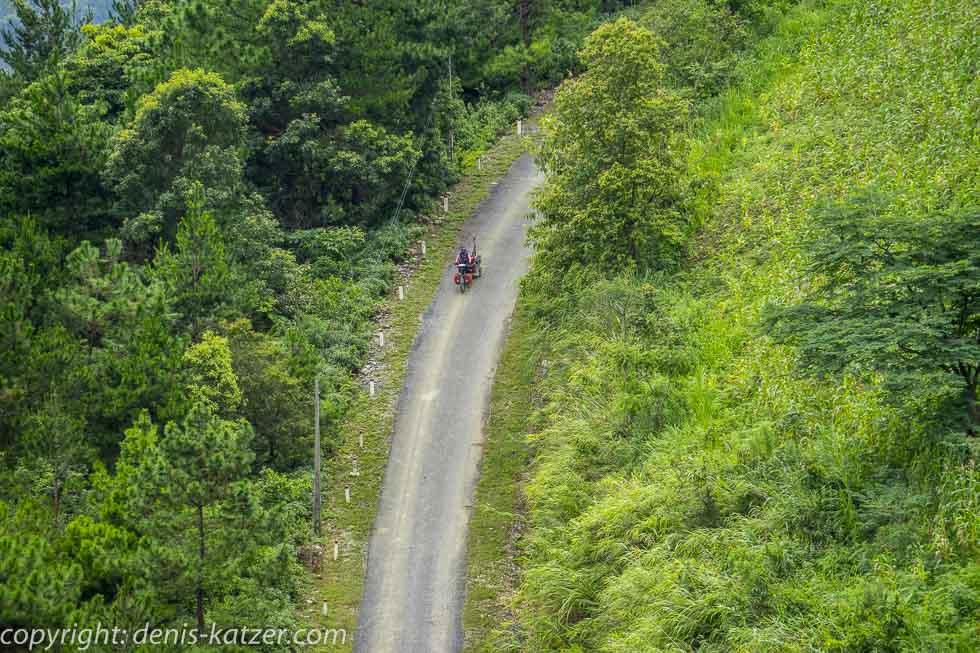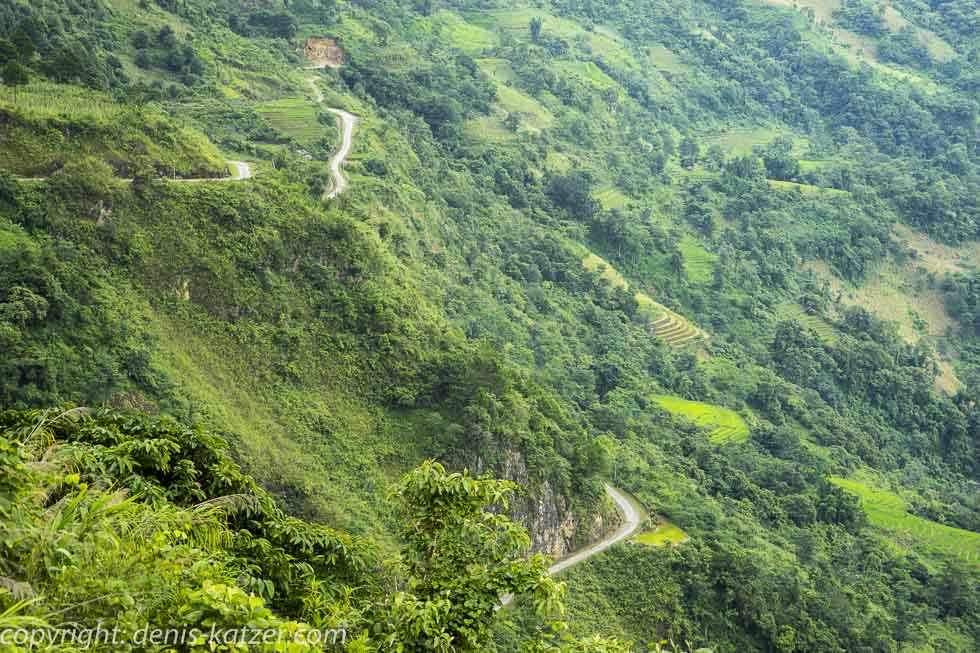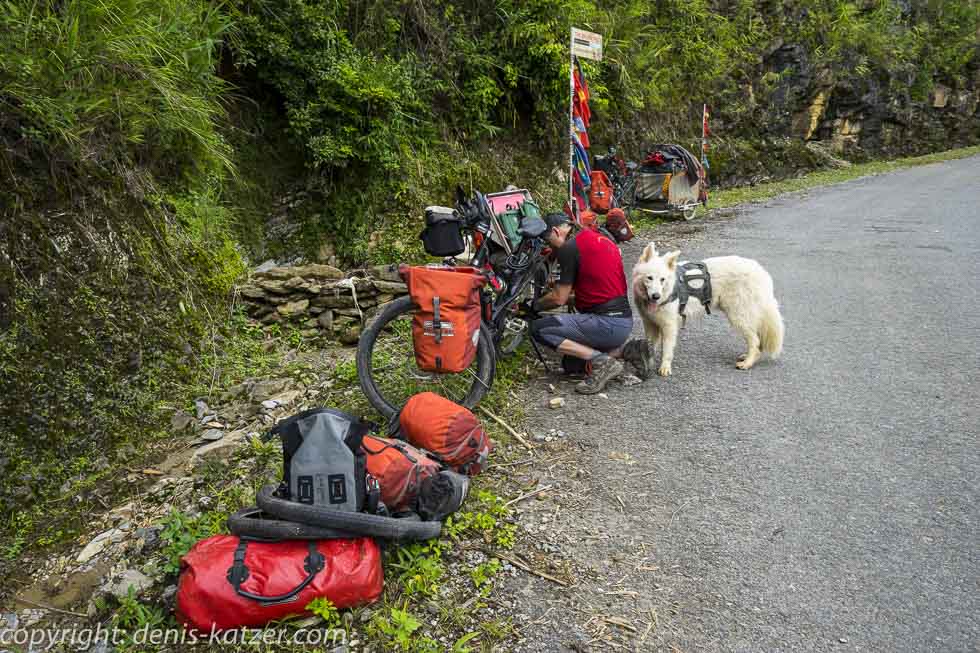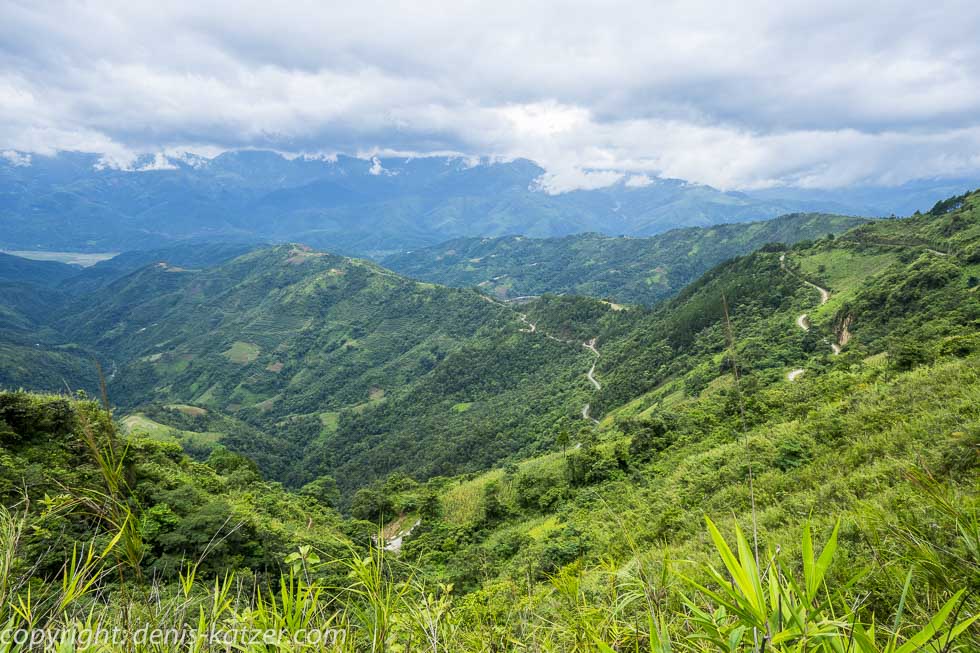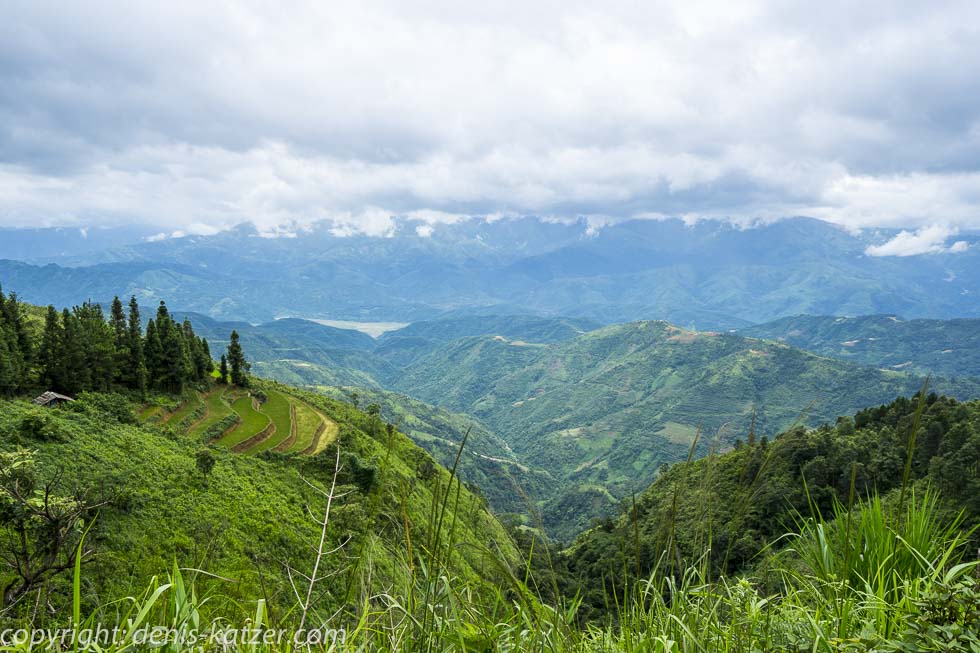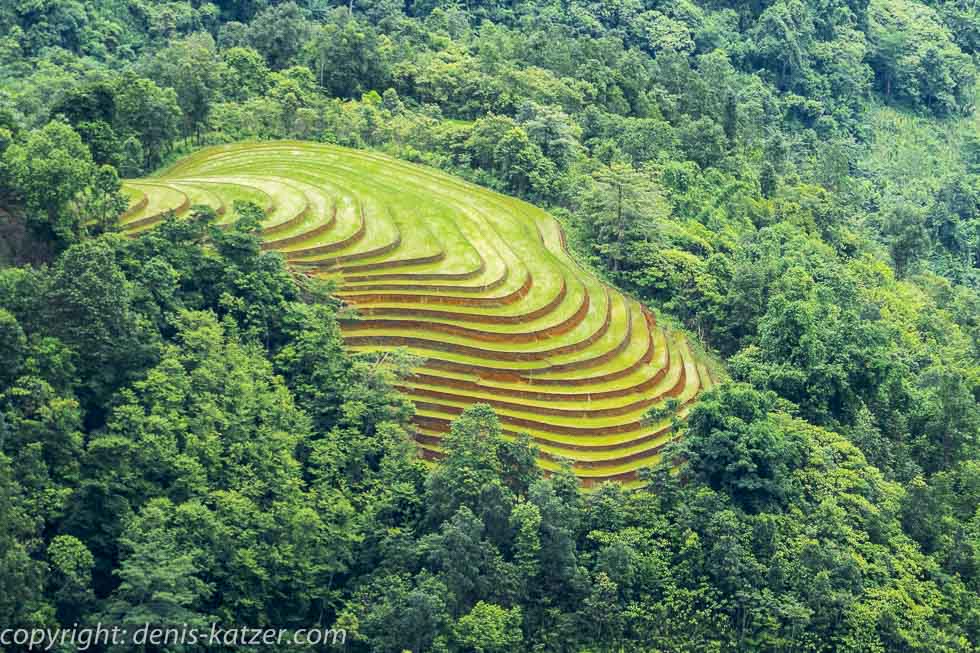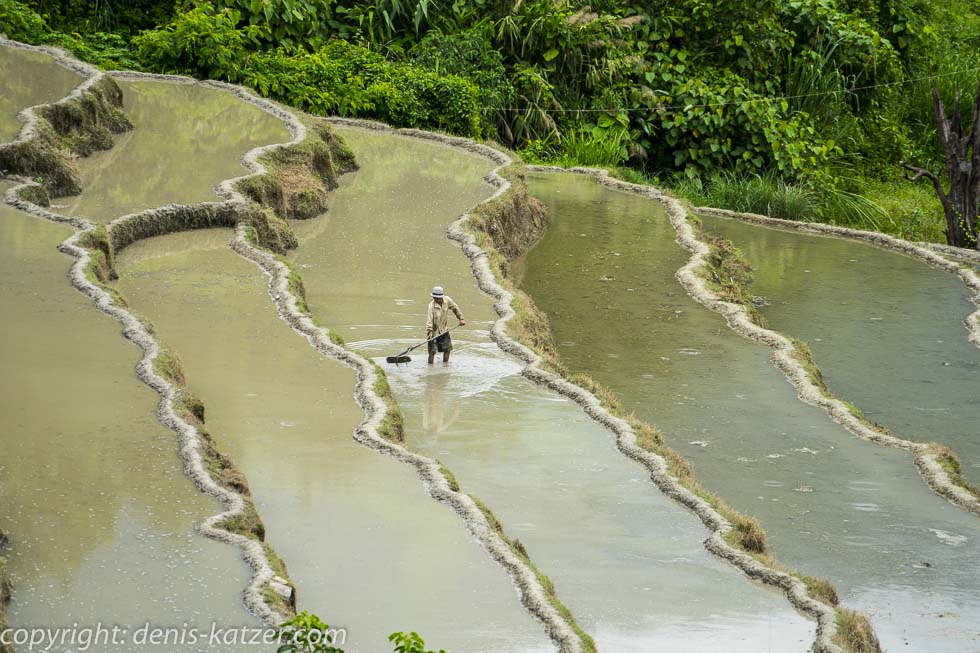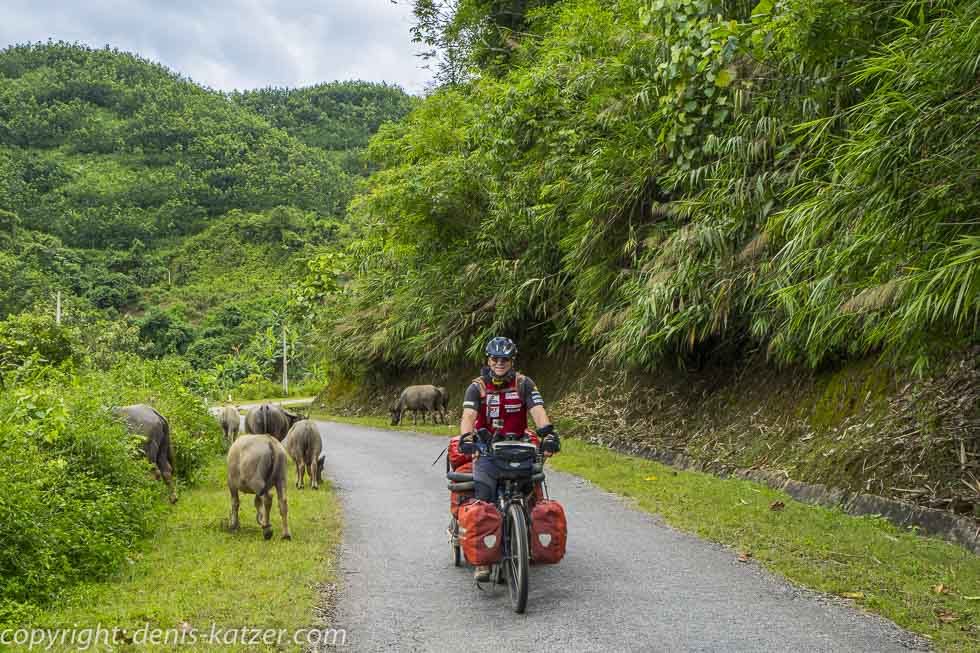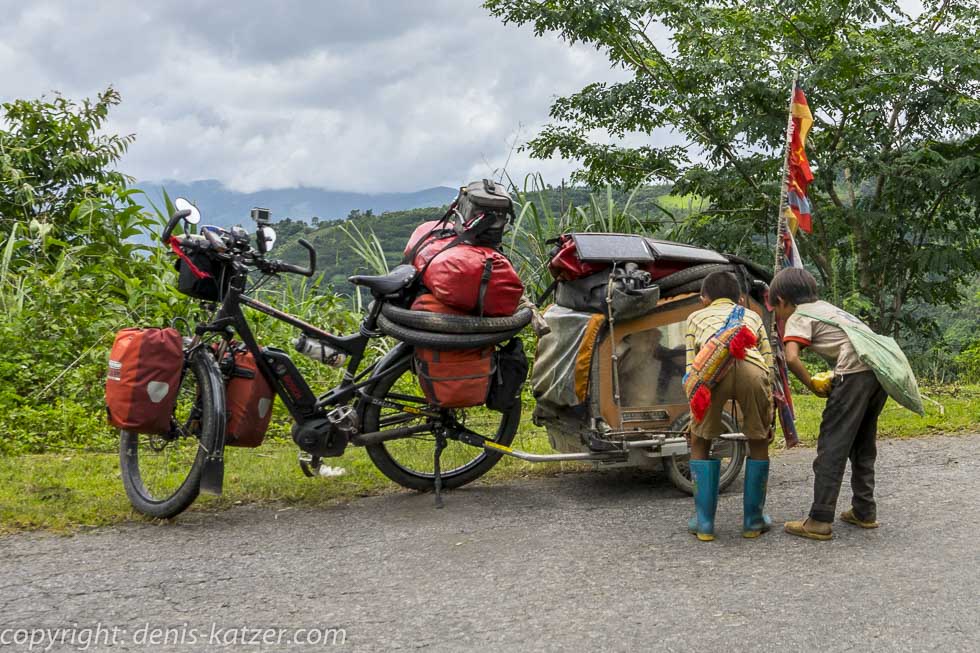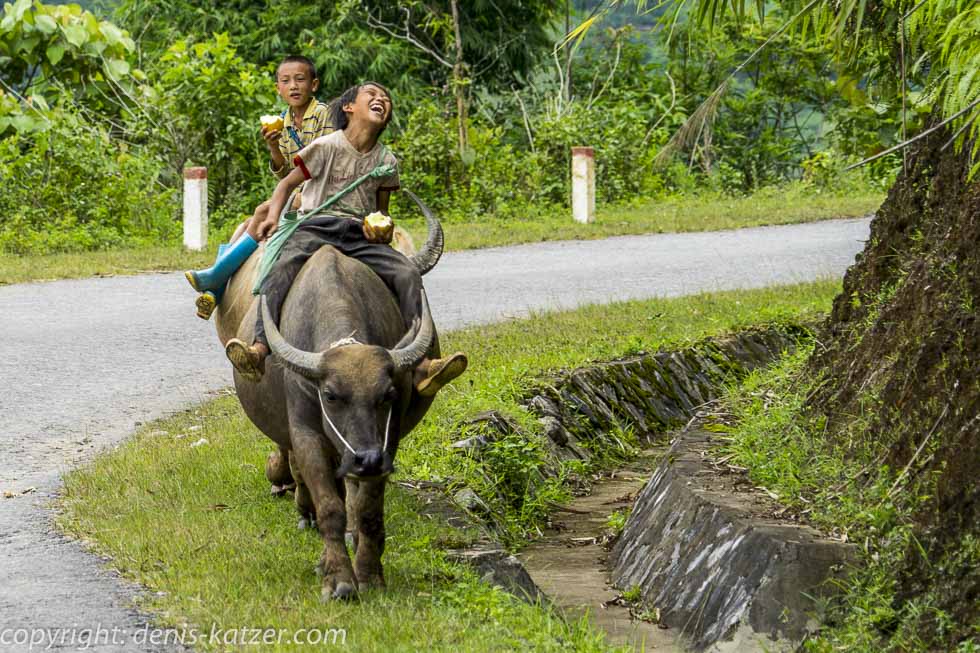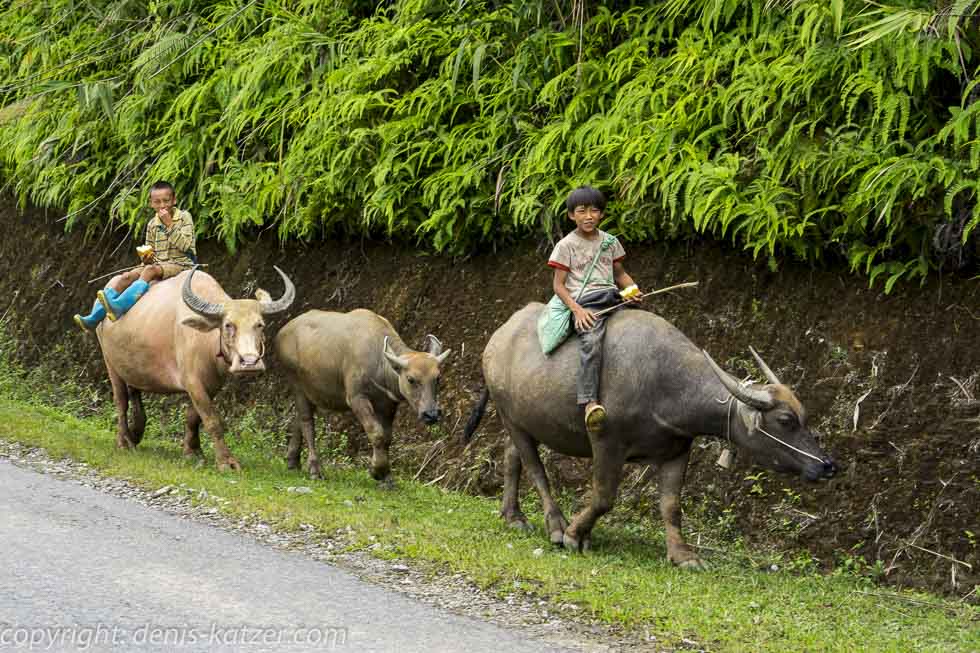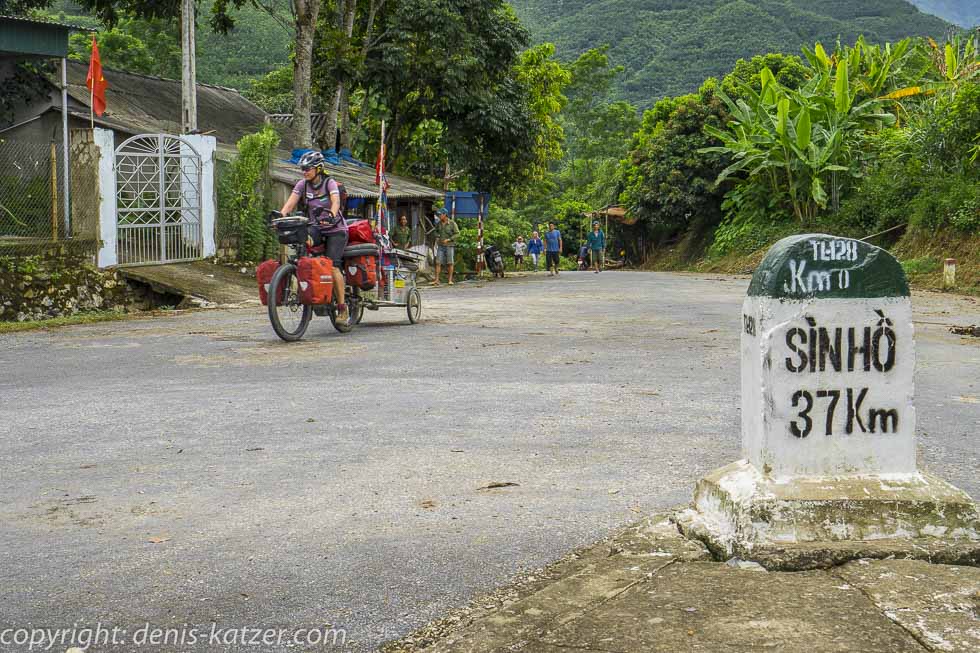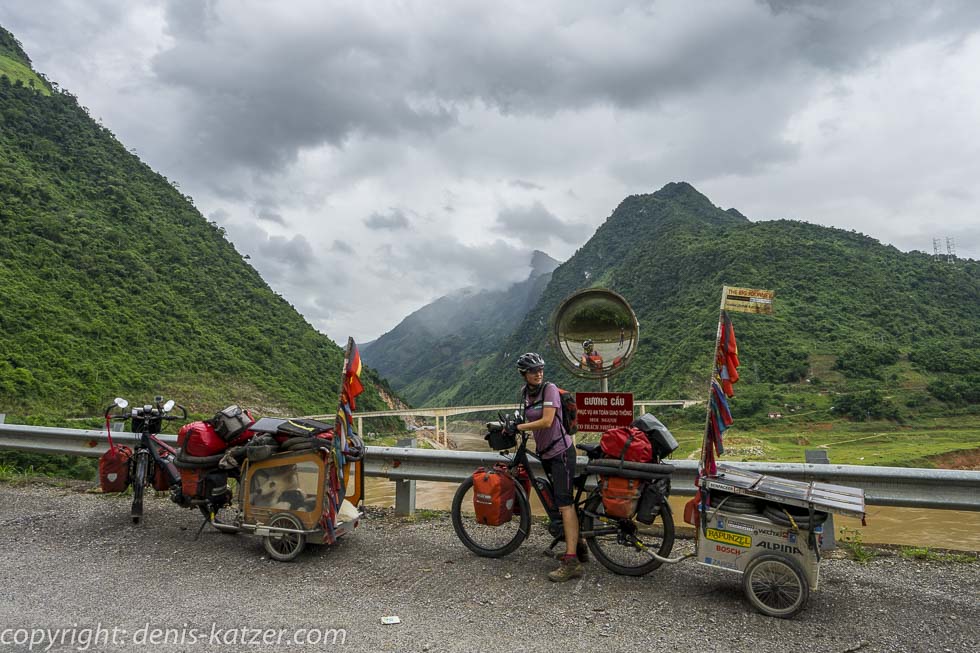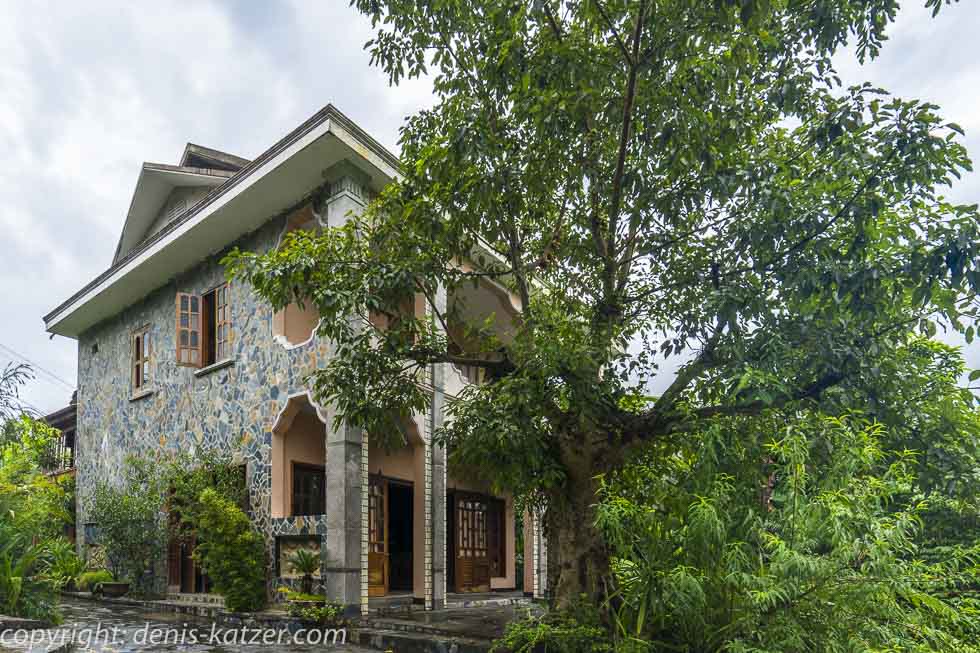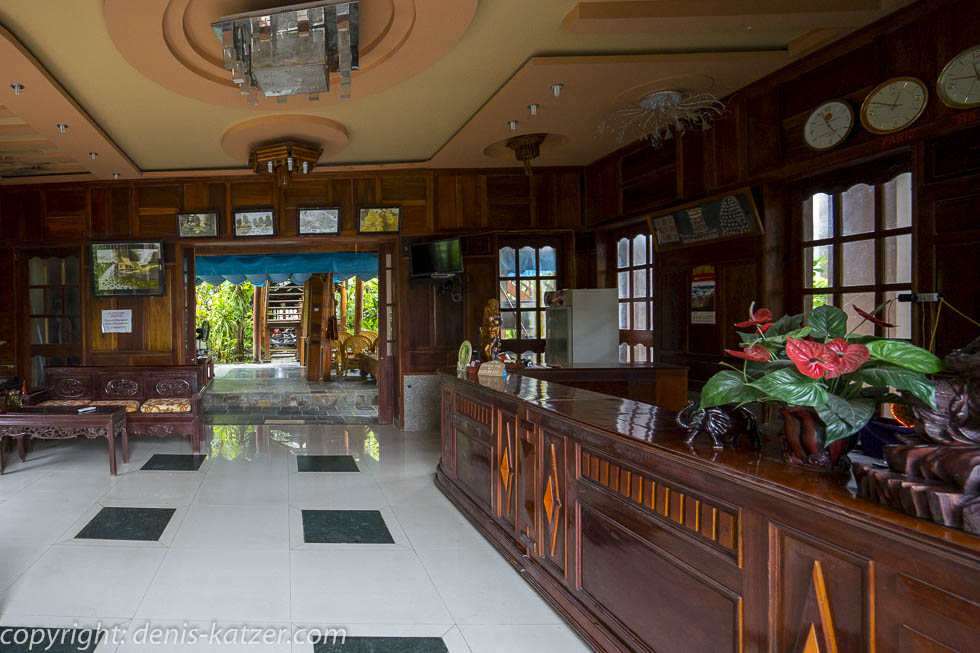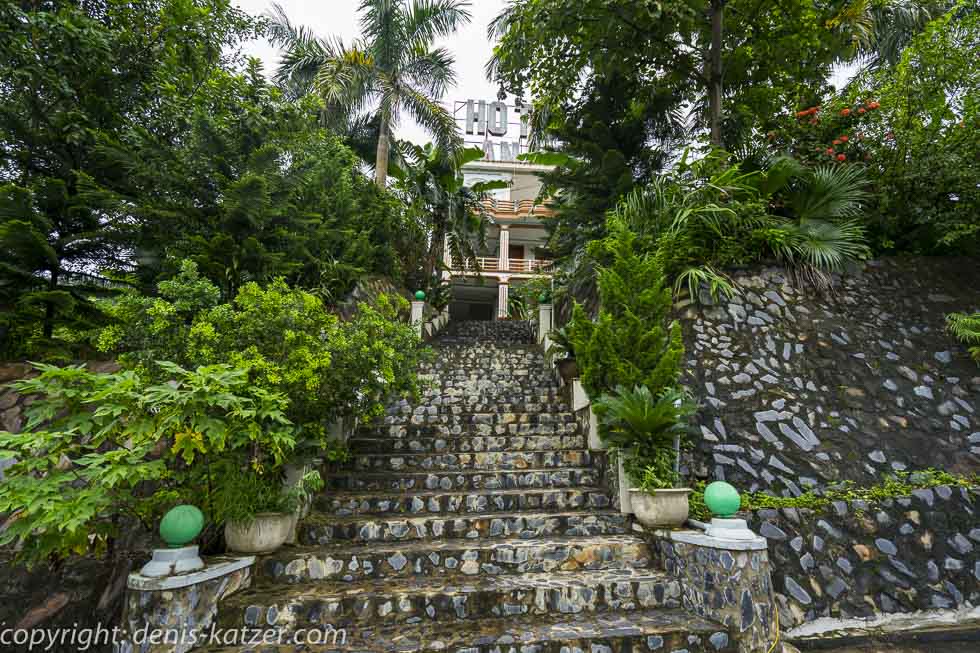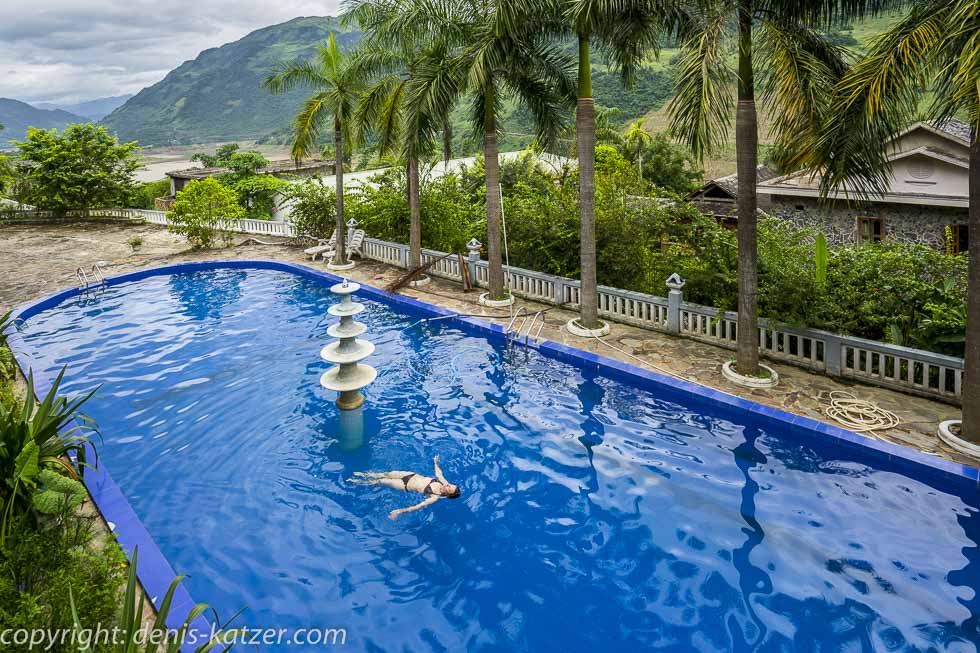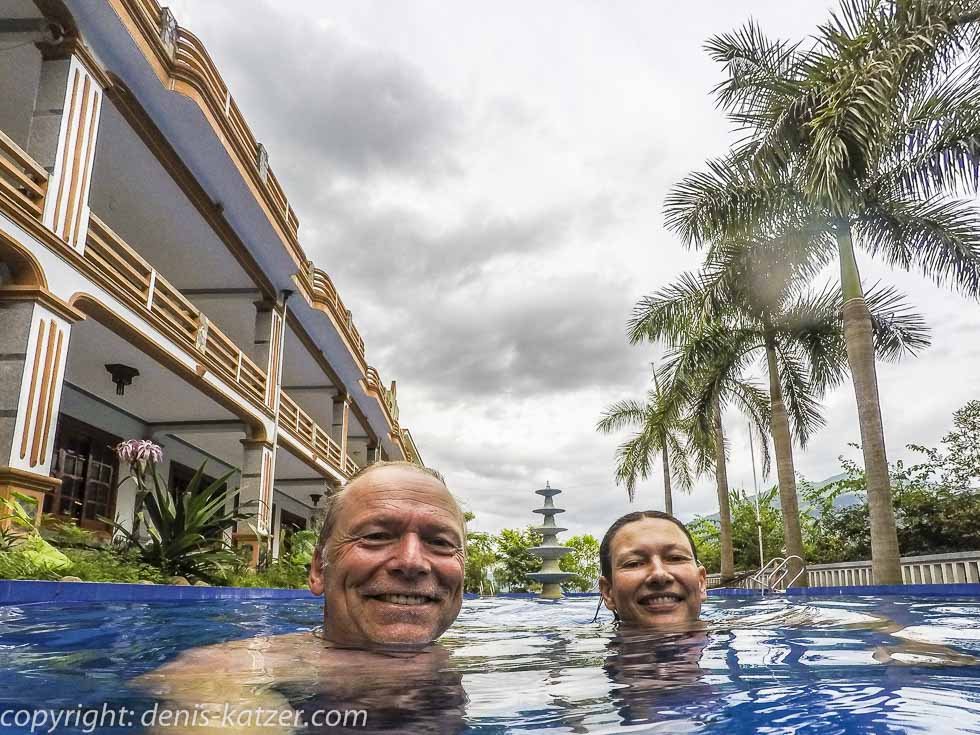
143 years of oppression and the fight for freedom
N 21°23'32.0'' E 103°01'07.8''
Date:
23.07.2016 until 26.07.2016
Day: 392 – 395
Country:
Vietnam
Province:
Điện Biên
Location:
Điện Biên Phủ
Latitude N:
21°23’32.0”
Longitude E:
103°01’07.8”
Daily kilometers:
22 km
Total kilometers:
17,787 km
As the crow flies:
8 km
Average speed:
20 km/h
Maximum speed:
40 km/h
Soil condition:
Asphalt
Maximum height:
1.600 m
Total altitude meters:
50.386 m
Altitude meters for the day:
80 m
Sunrise:
05:37
Sunset:
6:51 pm
Temperature day max:
29°C
Temperature day min:
22°C
(Photos of the diary entry can be found at the end of the text).
To learn about the country’s recent history, we hop on the saddles of our bikes and ride to the town of Điện Biên Phủ, which lies in a wide valley surrounded by mountains. We park our bikes below the Vietnamese war memorial and walk up the many steps under a blue sky and glistening sunshine. “What a beautiful view,” says Tanja. We sit on the steps and look down into the valley where the French troops were once trapped by an army of peasants and suffered one of the worst defeats in their history on May 7, 1954. “It must have been the purest inferno to sit down there in simple trenches while the world around you goes down in a terrible hail of grenades,” I say. “Yes, unimaginable and very sad,” Tanja replies thoughtfully. “Do you know how many people died in this battle?” she asks. “You mean just in this one battle?” “Yes.” “According to statistics I read on Wikipedia, around 3,500 Frenchmen were killed, 4,500 wounded and 9,000 taken prisoner during the 56-day battle, while there were 10,000 deaths and 15,000 wounded on the Vietnamese side. In total, the Indochina War started by the French cost 500,000 lives. Almost 60,000 of these were French, of whom only 20,700 were French citizens. The other soldiers were North African colonial troops and foreign legionnaires, around 55% of whom were German in 1954. The total death toll of Vietnamese fighters is estimated at 200,000, although there was never an official tally.” “Why did Germans fight in the French army?” “After the Second World War, the unemployment rate in Germany was very high. So some went to the neighboring country to enlist in the Foreign Legion. Others were looking for adventure, some were driven away from home by heartbreak and joined the legion. There were also many war orphans who no longer had any relatives and took the opportunity to turn their backs on a completely destroyed Germany. There were certainly also criminals who escaped punishment by joining the Legion, or former soldiers of the Waffen SS who sought and found shelter there. They all came and many of them found nothing but suffering and death here,” I explain.
“And why did the French actually start this war?” Tanja wants to know. “During the Second World War, they lost their colonial empire of French Indochina, which was based on what is now Laos, Cambodia and Vietnam, to Japan. After the Japanese were defeated, they wanted it back. But the Vietnamese wanted their independence and resisted renewed oppression and foreign rule.” “And that’s why the French started the Indochina War? Just to reclaim their former colonial empire?” “Exactly, and because this happened during the Cold War, the French were supported by the Americans while the USSR and China backed Vietnam. So it was also a proxy war between the superpowers of the time.” “Unbelievable. So the USA had its fingers in the pie long before the Vietnam War.” “Absolutely, they financed up to 80 percent of the entire Indochina War by supplying around 1,880 tanks and armored vehicles between 1950 and 1954, as well as 30,000 motor vehicles, around 360,000 firearms and 5,000 artillery pieces. Even 305 aircraft and 106 ships, including two aircraft carriers.” “That must have cost billions?” “Yes, if the Americans hadn’t supported the French, France would have gone bankrupt as early as 1952. From what I’ve read, this war cost over 8 billion US dollars.” “Man oh man. And now we’re sitting there looking at the peaceful-looking rice fields under which countless victims must lie,” says Tanja quietly.
“How did this battle actually come about in this remote region of Vietnam? What did the French want here?” Tanja breaks our silence. “That’s a good question. They wanted to cut off the Viet Minh, the Vietnamese rebels’ supply routes.” “What the Americans tried to do with their defoliation campaign using Agent Orange during the Vietnam War?” “Roughly. Điện Biên Phủ was to become a base to control the surrounding highlands. They hoped to gain control of the region’s rice and opium crops and wanted to create a retreat for pro-French partisans from the Thai and Hmong ethnic minorities.” “They were on the side of the French?” “Yes, that’s exactly why there was repression against these peoples after the Indochina and Vietnam wars and after the reunification of Vietnam. Even today, parts of Vietnamese society are reportedly still not on good terms with them.
“Hm, that’s interesting. And how did the Vietnamese manage to defeat a major military power like France, which was also massively supported by the USA?” “They simply underestimated the Vietnamese.” “Underestimated them?” “Yes, they hadn’t reckoned with the genius of Vo Nguyen Giap.” “Vo Nguyen Giap?” “He was an extraordinary general who had the idea of having his entire heavy artillery dismantled into individual parts and then having them hauled over the many jungle-covered mountains to Điện Biên Phủ on bicycles, handcarts and on the backs of his soldiers in an incomparable feat of strength. He then had them rebuilt in the surrounding mountains, put them in position, surrounded the overpowering French with his 72,000 fighters and literally bombed them out of the valley in just 56 days.” “Wow, and the French didn’t notice? I mean, they must have noticed something about this certainly extensive transportation operation and the preparations for the battle?” “They didn’t. There was no reconnaissance from the air because the Viet Minh could operate invisibly in the jungle and reconnaissance by small commando units was probably too dangerous in this area. However, the French had never believed that someone would come up with such a crazy idea of dismantling all the guns and then dragging them through a mountain jungle for weeks using muscle power. They were probably too sure of themselves and their superiority. The testimony of a veteran sheds light on this.” “They thought they had their tanks, their planes, their artillery and we had nothing. They underestimated us,” he said. “So the operation was a brilliant idea and logistical tour de force on the part of the general?” “An incomparable one, in fact. The battle that was won went down in history, had political consequences worldwide and is still studied by military historians all over the world because of its strategic masterpiece. In one of his last press conferences, the general had said that the battle had shown how strong a nation is when it has decided to stand up. He spoke of how proud his people are that Vietnam was the first colony to gain independence on its own with the victory of Điện Biên Phủ. Many of his soldiers were heroes, some went down in history. Be Van Dan, for example, attacked a French position by loading a cannon on his shoulder. Or Phan Dinh Giot sacrificed himself by blocking the French embrasures with his own body.
Incidentally, General Giap is still revered today and is considered the “Napoleon of the East” due to his tactical and strategic brilliance. He not only defeated the great power France, but also the world power America and drove the Chinese army back into their country. He only died in October 2013 at the biblical age of 102.”
We are still sitting on the steps below the war memorial, which was erected in memory of the many Vietnamese fallen, and look out over the valley, where there were no more than 24 houses at the time. Today’s lively Điện Biên Phủ, where there are hotels, restaurants, karaoke bars and a modern department store, is home to around 70,000 people and allegedly 300 veterans.
We look out over many lush rice fields, surrounded by the mountains on which the rebels sat over 60 years ago, waiting for their orders to deploy. The successful outcome of the battle for the Vietnamese heralded the end of the eight-year Indochina War, which in turn was only the prelude to the Vietnam War that raged immediately afterwards, from 1955 to 1973, and that after the withdrawal of the American troops, the fratricidal war between North and South Vietnam broke out, which only came to an end in May 1975, after a total of 30 years of war. One might think that the war-torn Vietnamese people had finally come to rest, but on February 17, 1979 at 3:30 a.m., Vietnam was attacked by the Chinese People’s Army due to years of border disputes with China. This renewed conflict, which resulted in losses, was not officially settled until 2001. Considering that French gunboats attacked the port of Đà Nẵng and the Mekong Delta as early as 1858, the country has suffered under the thumb of a foreign power ever since and only officially ended its last battles in 2001, that is 143 years of oppression and struggle.
If we didn’t know the human tragedies that have taken place in this tormented country, our visit to Điện Biên Phủ would have been just a trip to one of the exceptionally beautiful valleys of northern Vietnam. However, we know what the human race is capable of and are deeply affected every time we hear about it. In the hope that at some point in the future we humans will perhaps manage to live together in peace, harmony and harmony, we walk silently down the many steps to the city. And although it is not uplifting for us to visit former battlefields, military cemeteries and war museums, this sad part of a country’s history is also part of our journey. Only when you know both sides of a coin do you begin to understand the connections. And that is exactly what matters to us. Understanding, comprehension, learning, compassion, forgiveness, growth, knowledge, energy, love, because as ambassadors of Mother Earth it is important for us to look at a journey, a country, its society and religion from different angles and to report on it. Certainly a great task, a task that we can never fully accomplish in a single lifetime, but we are willing to capture most of what we experience in pictures and text…
If you would like to find out more about our adventures, you can find our books under this link.
The live coverage is supported by the companies Gesat GmbH: www.gesat.com and roda computer GmbH http://roda-computer.com/ The satellite telephone Explorer 300 from Gesat and the rugged notebook Pegasus RP9 from Roda are the supporting pillars of the transmission.Pegasus RP9 from Roda are the supporting pillars of the transmission.

